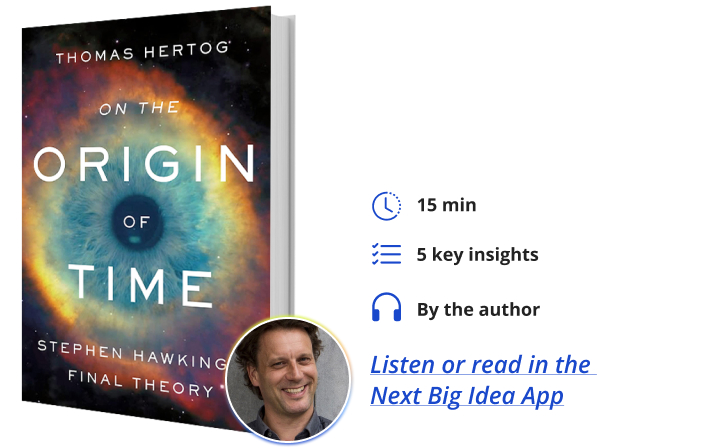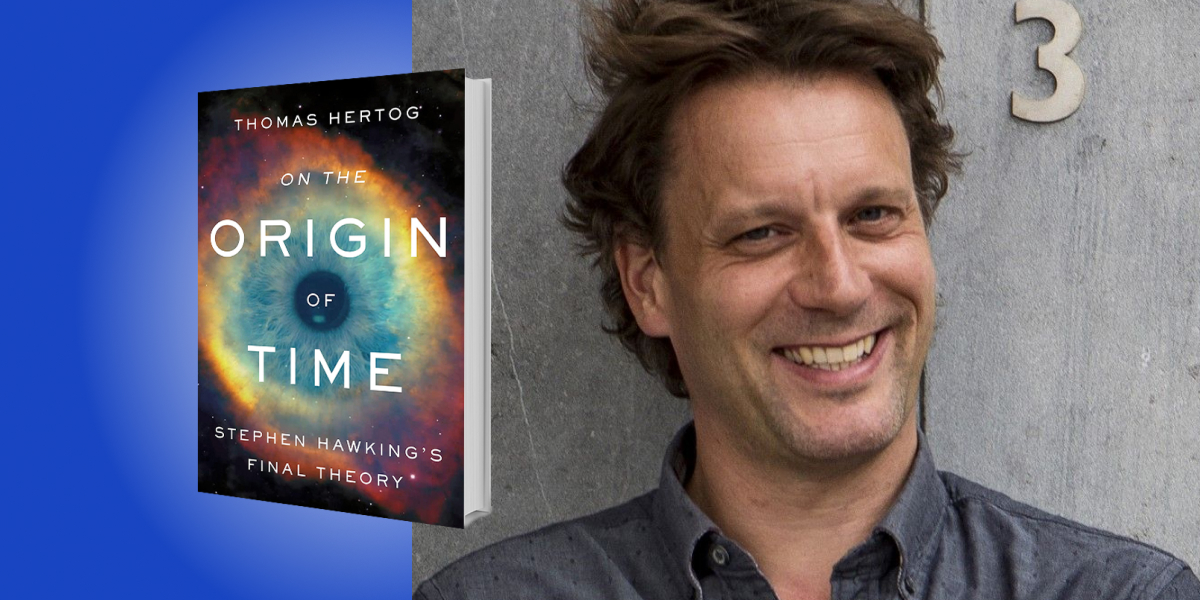Thomas Hertog is an internationally renowned cosmologist who was for many years a close collaborator of the late Stephen Hawking. He received his doctorate from the University of Cambridge and is currently a professor of theoretical physics at the University of Leuven, where he studies the quantum nature of the big bang.
Below, Thomas shares five key insights from his new book, On the Origin of Time: Stephen Hawking’s Final Theory. Listen to the audio version—read by Thomas himself—in the Next Big Idea App.

1. The Big Bang matters.
You might say, The Big Bang happened a long time ago, it’s over and done with, why should I bother? Well, Hawking and I came to a different view because of our baffling observation that the universe is very special. Down at the level of physics, it has just the right properties for life to be possible. It’s almost as if it was designed for life. That sounds crazy, and it is! Why did the Big Bang get the conditions for life right?
In the old days, it was thought that design meant there had to be a designer, or a final cause, saying that the universe was somehow destined to become our home. Today we point to the laws of physics, to the rules that underpin the evolution of the universe. These laws have striking, life-engendering properties. For example, there is enough matter to form stars and galaxies; the particle forces are delicately balanced so that we can have complex atoms like carbon; the universe doesn’t expand too fast; we have three dimensions of space, and so forth. Change any of these properties ever so slightly and life would hang in the balance.
Presumably, the laws of physics were imprinted on the universe at its birth. To grasp the deeper origin of the universe’s fitness for life, we must look back in time to the beginning.
There is a mindboggling arc that relates our existence today to the physical conditions at the Big Bang origin 13.8 billion years ago. Thinking about the Big Bang is thinking about us and our deepest roots.
2. There’s nothing before the Big Bang because there was no time.
We often think of the Big Bang as some sort of explosion that happened in a space that already existed. However, that isn’t quite correct. It looks like the Big Bang is not just an explosion, but a much more fundamental beginning: namely the beginning of time.
“The Big Bang does not have a cause because there is no prior time available for causality to be possible.”
The idea that time had a beginning in a big bang was championed in science during the early 1930s; it goes back to the work of the Belgian priest-astronomer Georges Lemaître. Yet, somewhat ironically, Albert Einstein famously rejected the idea of a big bang, because it reminded him of Christian dogma. Lemaître was a priest, which I presume didn’t help. But eventually, Hawking and Roger Penrose proved Lemaître right, suggesting that the universe was not made in time but with time. It is as if we finally found something without a cause; the Big Bang does not have a cause because there is no prior time available for causality to be possible.
Ever since, the origin of time has been the cornerstone, but also the Achilles’ heel of big bang cosmology. How exactly could time pop into existence?
3. It’s Darwin all the way down!
This is the crux of the hypothesis that Hawking and I put forward. Ever since Darwin’s theory of evolution, there has been a bit of a schism between biology and physics. Biological evolution since Darwin is all about change. We think of the laws of biology as the result of evolution, not as eternal truths. Physics is also about change, but we think it rests on immutable principles and mathematical equations that we call the laws of physics. Well, Hawking and I arrived at a different picture.
We looked back at the very earliest stages of the universe through the lens of quantum theory. When you do so, you find a deeper level of evolution: a level at which the laws of physics co-evolved together with the primeval universe taking shape in a Darwinian-like process of variation and selection playing out in the most primitive environment of the hot Big Bang.
“The crux of our cosmogenesis is that this drive toward more simplicity and less structure in the earliest universe continues until, in the end, evolution wins.”
Going back to the earliest of times, the laws simplify; the different forces and particle species merge with one another. The crux of our cosmogenesis is that this drive toward more simplicity and less structure in the earliest universe continues until, in the end, evolution wins. Not the laws but their capacity to change and evolve has the final word.
This is a grand new hypothesis. We’re saying that biological evolution and cos¬mological evolution aren’t fundamentally separate phenomena, but two vastly different levels of one giant evolutionary tree. Biological evolution is concerned with branches up in a high-complexity realm, whereas cos¬mology and astrophysics deal with lower-complexity layers.
Above all, we’re saying that the broad principles of Darwinism, that quintessential biological scheme, reach all the way down to the deepest level of evolution. This reveals a profound and powerful unity in nature. It is proper that Hawking’s ashes are buried in Westminster Abbey in between the graves of Darwin and Newton.
4. The universe may be a hologram.
The mathematics behind our new hypothesis isn’t easy. This is because this is about intermingling the immensely small and with the extremely large—a notoriously difficult marriage.
In effect, we envisage the earliest stages of the universe like a holographic projection. In a familiar hologram to most, a third dimension of space emerges from the lines and scribbles on a screen. In the cosmos-as-hologram idea, it is the dimension of time that holographically projects down.
Stephen and I found that it helps to think of this holographic projection of the early evolution of the universe like a disk, somewhat like Escher’s famous projection of angels and demons. The origin of the universe lies at the center of the disk and it expands outward in the radial direction. The edge of the disk would be the universe today. That edge plays the role of the holographic screen.
“In the cosmos-as-hologram idea, it is the dimension of time that holographically projects down.”
If there is a code operating on the entangled qubits that bring about the history of the universe, and this is what we perceive as the flow of time, then how do we go back in time? We do so by taking a fuzzier view of the hologram. One ventures farther back in time, toward the interior of the disk, by taking a blurry view of the screen. It is like zooming out. Eventually, however, one runs out of bits. This would be the origin of time, according to our theory. There can be nothing before the Big Bang because the past that holographically emerges doesn’t extend further back.
5. What physics ultimately uncovers about the world.
The younger Hawking sought a deeper understanding of the universe’s appar¬ent design in the physical conditions at the origin of time. He assumed there was a fundamental causal explanation hidden deep in the math governing the Big Bang that determines “why the universe is the way it is,” as he so often put it. That is, he assumed there was a final theory hovering above the physical universe—or even the multiverse—like an eternal truth.
The later Hawking realized that his earlier alter-ego had made a mistake. Our fresh Darwinian-like perspective on the earliest stages of the universe rejects the idea that the universe is like a machine governed by unconditional laws with some sort of prior existence. Rather, it radiates the idea that the universe is a kind of self-organizing entity, in which all sorts of emergent patterns appear, the most general of which we call the laws of physics.
One might say that in our new cosmology, physics itself fades away back into the Big Bang. The Big Bang in our theory isn’t so much the beginning of time as it is the beginning of laws. It is almost an epistemic horizon involving no space, no time, and no physical laws.
To listen to the audio version read by author Thomas Hertog, download the Next Big Idea App today:































